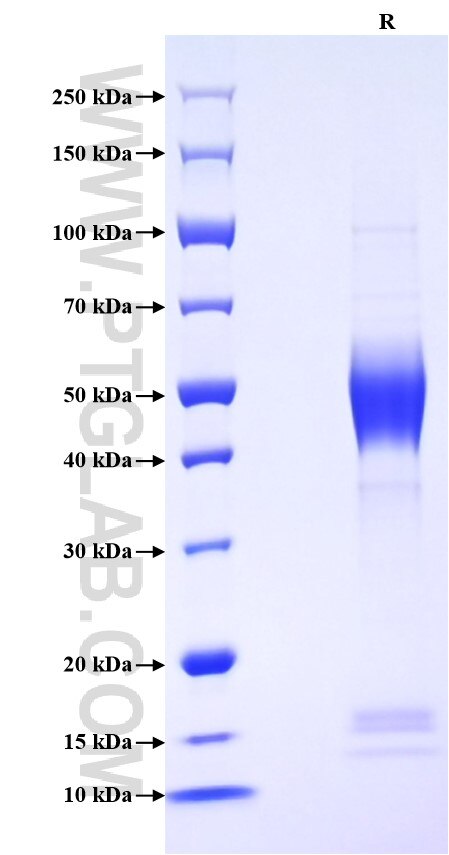Recombinant Human HBEGF protein (rFc Tag)
Species
Human
Purity
>90 %, SDS-PAGE
Tag
rFc Tag
Activity
not tested
Cat no : Eg3862
Validation Data Gallery
Product Information
| Purity | >90 %, SDS-PAGE |
| Endotoxin | <0.1 EU/μg protein, LAL method |
| Activity |
Not tested |
| Expression | HEK293-derived Human HBEGF protein Leu20-Thr160 (Accession# Q99075) with a rabbit IgG Fc tag at the C-terminus. |
| GeneID | 1839 |
| Accession | Q99075 |
| PredictedSize | 42.0 kDa |
| SDS-PAGE | 13-17 kDa & 42-54 kDa, reducing (R) condition |
| Formulation | Lyophilized from 0.22 μm filtered solution in PBS, pH 7.4. Normally 5% trehalose and 5% mannitol are added as protectants before lyophilization. |
| Reconstitution | Briefly centrifuge the tube before opening. Reconstitute at 0.1-0.5 mg/mL in sterile water. |
| Storage Conditions |
It is recommended that the protein be aliquoted for optimal storage. Avoid repeated freeze-thaw cycles.
|
| Shipping | The product is shipped at ambient temperature. Upon receipt, store it immediately at the recommended temperature. |
Background
The epidermal growth factor (EGF) family member, heparin-binding EGF-like growth factor, (HBEGF), is present in the uterus at the time of embryo implantation, and its expression in trophoblast (TB) cells of the placenta indicate its central role in early implantation and subsequent placentation. HBEGF protects TB cells from apoptosis, and promotes their invasion. Transmembrane HBEGF cleavage in response to low O2 initiates autocrine signaling that increases HBEGF levels to a concentration that inhibits apoptosis. The autocrine upregulation of HBEGF requires activation of its cognate receptors (ERBB1 and ERBB4), and downstream signaling through any one of three MAPK pathways initiated by MAPK 1/3, MAPK14 or MAPK8.
References:
1. Yoo, H J et al. Developmental genetics vol. 21,1 (1997): 102-8. 2. Leach, R E et al. The Journal of clinical endocrinology and metabolism vol. 84,9 (1999): 3355-63. 3. Armant, D Randall et al. Development (Cambridge, England) vol. 133,4 (2006): 751-9. 4. Jain, Chandni V et al. PloS one vol. 11,10 (2016) e0163913. 5. Jessmon, Philip et al. Biology of reproduction vol. 82,5 (2010): 921-9.

